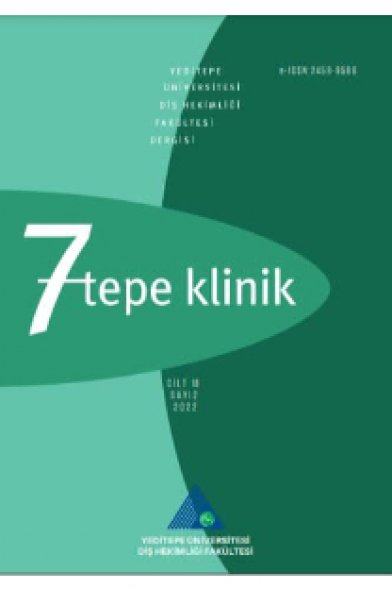The effect of different beverages on the surface roughness and hardness of soft denture lining materials
Farklı içeceklerin yumuşak astar maddelerinde sertlik ve yüzey pürüzlülük üzerine etkisi
___
- 1. Brown D. Resilient soft liners and tissue conditioners. Br Dent J 1988; 164: 357-360.
- 2. Tata S, Nandeeshwar DB. A clinical study to evaluate and compare the masticatory performance in complete denture wearers with and without soft liners. J Contemp Dent Pract 2012; 13: 787-792.
- 3. Akin H, Tugut F, Mutaf B, Guney Ü. Investigation of bonding properties of denture bases to silicone-based soft denture liner immersed in isobutyl methacrylate and 2-hydroxyethyl methacrylate. J Adv Prosthodont 2014; 6: 121-125.
- 4. Murata H, Hamada T, Sadamori S. Relationship be-tween viscoelastic properties of soft denture liners and clinical efficacy. Jpn Dent Sci Rev 2008; 44: 128-132.
- 5. Wi?ckiewicz W, Kasperski J, Wi?ckiewicz M, Miernik M, Krol W. The Adhesion of Modern Soft Relining Materials to Acrylic Dentures. Adv Clin Exp Med 2014; 23: 621-625.
- 6. El-Hadary A, Drummond JL. Comparative study of wa-ter sorption, solubility, and tensile bond strenght of two lining materials. J Prosthet Dent 2000; 83: 356-361.
- 7. Pavan S, Filho JNA, Santos PH, Nogueira SS, Batista AUD. Effect of Disinfection Treatments on the Hardness of Soft Denture Liner Materials. J Prosthodont 2007; 16: 101-106.
- 8. Mese A, Guzel KG. Effect of storage duration on the hardness and tensile bond strength of silicone- and acryl-ic resin-based resilient denture liners to a processed den-ture base acrylic resin. J of Prosthet Dent 2008; 99: 153-159.
- 9. Bail M, Jorge HJ, Urban VM, Campanha NH. Surface Roughness of Acrylic and Silicone-Based Soft Liners: In Vivo Study in a Rat Model. J Prosthodont 2014; 23: 146-151.
- 10. Machado AL, Giampaolo ET, Vergani CE, et al. Chang-es in roughness of denture base and reline materials by chemical disinfection or microwave irradiation: surface roughness of denture base and reline materials. J Appl Oral Sci 2011; 19: 521-528.
- 11. Qudah S, Harrison A, Huggett R. Soft lining materials in prosthetic dentistry: a review. Int J Prosthodont 1990; 3: 477-483.
- 12. Urban VM, Lima TF, Bueno MG, Giannini M, Arioli Fil-ho JN, de Almeida AL, Neppelenbroek KH. Effect of the addition of antimicrobial agents on Shore A hardness and roughness of soft lining materials. J Prosthodont 2015; 24: 207-214.
- 13. Huddar DA, Hombesh MN, Sandhyarani B, Chandu GS, Nanjannawar GS, Shetty R. Effect of denture cleanser on weight, surface roughness and tensile bond strength of two resilient denture liners. J Contemp Dent Pract. 2012; 13: 607-611.
- 14. Gedik H, Ozkan YK. The effect of surface roughness of silicone-based resilient liner materials on the adherence of Candida albicans and inhibition of Candida albicans with different disinfectants. Oral Health Prev Dent 2009; 7: 347-353.
- 15. Leite VM, Pisani MX, Paranhos HF, Souza RF, Silva-Lo-vato CH. Effect of ageing and immersion in different bev-erages on properties of denture lining materials. J Appl Oral Sci 2010; 18: 372-378.
- 16. Azevedo A, Machado AL, Vergani CE, Giampaolo ET, Pavarina A, Magnani R. Effect of Disinfectants on the Hardness and Roughness of Reline Acrylic Resins. J Prosthodont 2006; 15: 235-242.
- 17. Safari A, Vojdani M, Mogharrabi S, Iraji Nasrabadi N, Derafshi R. Effect of beverages on the hardness and ten-sile bond strength of temporary acrylic soft liners to acryl-ic resin denture base. J Dent Shiraz Univ Med Sci 2013; 14: 178-183.
- 18. Kim BJ, Yang H, Chun M, BS, Park Y. Shore hardness and tensile bond strength of long-term soft denture Lin-ing materials. J Prosthet Dent 2014; 112: 1289-1297.
- 19. Garcia RM, Léon BT, Oliveira VB, Del Bel Cury AA. Ef-fect of a denture cleaner on weight, surface roughness, and tensile bond strength of two resilient denture liners. J Prosthet Dent 2003; 89: 489-494.
- ISSN: 2458-9586
- Yayın Aralığı: 3
- Başlangıç: 2005
- Yayıncı: Yeditepe Üniversitesi Rektörlüğü
İki farklı bonding sisteminin erozyonlu mine dokusunda bağlanma dayanımlarının karşılaştırılması
İbrahim ŞİMŞEK, Buket AYNA, ERSİN UYSAL
Alican PAMAY, Mete BUYUKERTAN, HÜSEYİN AVNİ BALCIOĞLU
Ponticulus posticus: is it important for a dentist as a radiological finding?
Şeyma ALLA, Selim Aydın GÜMÜŞDAL, EROL CANSIZ, Mehmet Ali ERDEM, Sabri Cemil İŞLER
Temporomandibular eklem bozuklukları ve teşhisi
MEHMET YALTIRIK, Alen PALANCIOĞLU, MELTEM KORAY, Cevat Tuğrul TURGUT
GÖKHAN GÜRLER, EMRAH DİLAVER, Erkan SOYLU, Tuba DEVELİ, BARIŞ ÇAĞRI DELİLBAŞI
Using different anaesthesia techniques during arthrocentesis: case series
YUSUF EMES, Itır Şebnem BİLİCİ, Buket AYBAR, Uğur AGA, Melike SÜBAY ORDULU, HALİM İŞSEVER, Serhat YALÇIN, Anıl CESUR
